The Ultimate Guide To Mui Ne Beach Resort: Awe-Inspiring Sand Dunes In Vietnam

We first rolled into Mui Ne on our newly bought Yamaha Nouvo automatic motorcycle on the late afternoon of a November’s day.
All of a sudden, there was that unmistakable coastal vibe, so often detectable long before the ocean or the sandy beaches are within sight or earshot. Coconut palms and extravagant beach resorts lined the 10 km long coastal road as we cruised along it slowly with the fresh, salty sea breeze ruffling our hair.
What a relief it was to be here in such a beautiful place at last, after our tiring 8-hour long motorcycle journey on the chaotic roads of Vietnam, from Ho Chi Minh City.
We spent the next few days dining on delicious seafood, exploring picturesque fishing villages, deserted beaches and sweeping sand dunes. We also took a free kitesurfing lesson and waded along a geological wonder known as the ‘fairy stream’.
Mui Ne was a destination that we’ll never forget and it stood out for us as one of the major highlights of our 2-month motorcycle journey through Vietnam.
Location
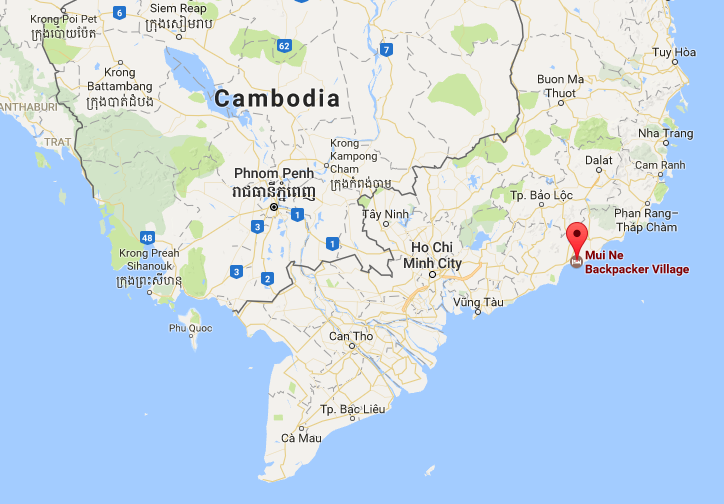
Mui Ne is a resort located in Binh Thuan Province on Vietnam’s east coast. It lies about 215 km east of Ho Chi Minh city and only about 11 km east of Phan Thiet, the provincial capital and nearest transport hub.
Getting to Mui Ne
Flying into Mui Ne or Phan Thiet is impossible as neither have an airport. The nearest international airport is Lien Khuong Airport, which is 130km away and serves the city of Dalat in the central highlands. Cam Ranh International Airport near Nha Trang is 190km away and Tan Son Nhat International Airport in Ho Chi Minh is 200 km away.
By bus:
There are several bus companies serving the route from Ho Chi Minh city to Mui Ne. Phuong Trang (futa bus) is one of the more reliable national bus companies. Another fairly reputable company is the Tam Hanh bus company. The Sinh tourist is one of the more reliable open tour buses.
Most of these bus companies operate early morning services from HCMC, Nha Trang and Dalat, with some offering an additional afternoon service. Phuong Trang provides regular buses from early morning until late at night. Tickets for all journeys should cost around $4 - $5. The journey takes about 5-6 hours.
By rail:
Mui Ne doesn’t have a train station but there are early morning trains from Saigon train station to Phan Thiet. The cost is around $5 and the journey takes about 5 hours.
From Phan Thiet you can catch the red local bus to Ham Tien (the tourist strip). If no connecting bus is available, you can also take a taxi or xe om (motorbike taxi) from the station. Some hotels will also arrange pick-ups.
You can browse the official railway website www.vr.com.vn for the full train schedule and prices.
Mui Ne - A little background info
.jpg)
Back in the early 90's, Mui Ne was a relatively underdeveloped bolt-hole for expats and savvy tourists; a peaceful coastal getaway from the more manic tourist hotspots in Vietnam. The road lining the main stretch of beach was relatively empty, save for a few low-profile resorts, guesthouses and restaurants.
Today it's an entirely different story. The road lining the main beach is jam-packed with hundreds of resorts, shops, bars restaurants, ATM machines and other businesses catering to tourists' whims and fancies. Busloads of Vietnamese, Japanese and Chinese tourists arrive daily during the peak season.
That said, the place still retains an irresistible charm and we must admit that the hordes of narcissistic selfie-stick wielding tourists here didn't manage to significantly hamper our enjoyment of the destination.
Mui Ne is blessed with fine weather (2,459 hours of sunshine per year) and annual temperatures here average a balmy 27°C. Due to the sweeping sand dunes that encompass it, Mui Ne also has a unique microclimate, only receiving about half the rainfall of it’s neighbouring city, Phan Thiet. Even during the monsoon season (June to September), the rains are light and infrequent here and the area just north of here is supposedly the driest place in all of Vietnam.
The beach is dominated by Russian package tourists, who greatly outnumber all other nationalities by a long shot. Hence it has been dubbed 'Russia town' by expats and you'll find a lot of the restaurant menus are translated into Russian. However, with the recent decline in the value of the ruble (Russian currency), the number of Russians visiting here has also taken a dive in recent years.
In October 1995, it was announced by scientists that Binh Thuan would be the only place in Vietnam where a full solar eclipse would be visible. Thousands of people rushed to Phan Thiet and Mui Ne and it's said that this event sparked the beginning of the tourist industry in the region.
When to visit
The best time to visit Mui Ne depends on what you intend to do there. Regarding weather, Mui Ne is pretty dry all year round due to the unique microclimate so any time of year should yield plenty of fine weather for sun-seekers.
If you’re travelling on a budget or would like to avoid the crowds, be aware that the peak tourist season is from November to April, so come outside those months for a better chance of securing a bargain on accommodation and avoiding the plagues of tourists.
Mui Ne is also popular for watersports, especially windsurfing and kitesurfing and if that’s the primary reason for your visit, the best time of year would be from October to the end of March due to consistently stronger winds and bigger waves during those months. The peak months are December and January. Winds tend to be weaker and more inconsistent during the monsoon season.
Where To Stay
With hundreds of options along the main drag, it's not at all difficult to find a suitable place to stay. Most guesthouses and hotels here have high standards. Your main task will be to sniff out the places that offer that great value at a low price. The key to getting an awesome deal is to always try to bargain until you find somebody who agrees to your price.
When we arrived, we only had to check a handful of guesthouses before we found a great bargain. A woman who ran a guesthouse near the fairy stream offered us a spacious, spotlessly clean room with a large attached bathroom for just $6 per night (after some bargaining). We were amazed and delighted, especially since we had come during the high-season.
Where To Eat
You won't struggle to find great restaurants in Mui Ne, with literally dozens of options. Most of the tourist-oriented restaurants specialize in seafood and you can dine on fish, squid, prawns, lobster, crab, oysters, mussels and varieties of local shellfish. You'll see the seafood on display outside restaurants to tempt you in, usually kept fresh in beds of ice or kept alive inside aerated tanks of saltwater.
Unfortunately, these tourist-oriented seafood restaurants are a lot more expensive than the local ones since a lot of them are geared at free-spending Russian tourists (and seafood is expensive anyway).
Budget travellers can also find a few cheaper low-profile restaurants along the main drag that sell more basic local Vietnamese food like rice and noodle dishes. You can also head to Mui Ne fishing village and seek out some cheaper local restaurants where it may be possible to order seafood for a lower price. Phan Thiet also has a good range of local restaurants and more seafood places if you're willing to drive out to it.
The local specialty is fish sauce (nuoc mam), made by fermenting fish for several months inside vats filled with brine. It's used as a condiment with meals and the local economy heavily relies it for income, with about 10% getting exported to Europe, U.S.A, Japan and South Korea and the rest sold domestically.
Dragon fruit (Thanh Long) or pitaya is another local specialty which is actually grown in the province thanks to the dry tropical climate. If you've never tried dragon fruit before, try it here. The fruit comes from a cactus-like plant (Hylocereus undatus), is absolutely delicious and comes in either a white or pink-fleshed variety.
The Layout
.png)
Mui Ne is essentially the name given by the tourist industry to the long curve of sandy beach (truly named Rang beach) that stretches along the coast for over 10km, just to the west of the picturesque fishing village of Mui Ne.
A long road called Nguyen Dinh Trieu street follows the curve of Rang beach and is lined with hundreds of shops, bars, cafes, souvenir shops, restaurants, ATMs, laundry services and a plethora of accommodation options for all budget ranges, including some very upscale and extravagant resorts.
Most of the attractions, including the picturesque Mui Ne fishing village, the enchanting fairy stream, the red sand dunes and the Po Shanu cham towers lie in close proximity to Rang beach. The white sand dunes and isolated beaches are a little further afield.
5 awesome things to do in Mui Ne
If you're here to do more than just relax, lounge around and soak up the sun, Mui Ne has plenty to offer. Here are our top 5 picks of things to do while you're here:
1. Experience the awe-inspiring sand dunes
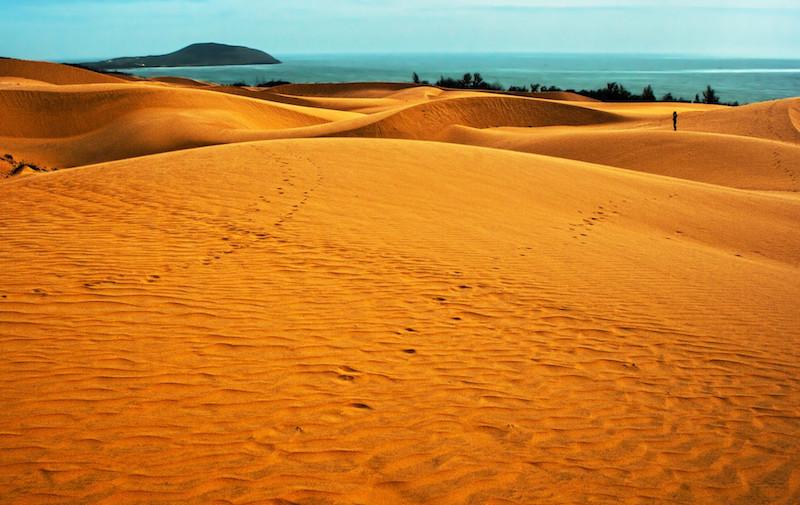
The expansive red and white sand dunes that Mui Ne is famous for, are in fact partially responsible for safeguarding its unique dry microclimate.
The dunes are formed by the strong onshore winds that blow tiny grains of sand inland. When the sand grains become trapped by various obstacles they begin to accumulate and the dunes begin to form. The dunes are a very dynamic structure, constantly being re-sculpted and reshaped by the ceaseless oceanic winds that blow across them.
The red and white sand dunes are in fact two separate sand dune formations in completely different locations and they're both well worth seeing.
The red sand dunes (doi hong)

The red sand dunes are located close to Mui Ne fishing village, about 2.8km north of it along route DT716.
Getting there: Getting to the sand dunes is relatively straightforward if you're staying by the main Mui Ne beach. Just follow the coastal road heading east and go past the scenic fishing harbour on your right. Take the left turn at the Christian church and turn left again at the T-junction at the end of this road. Go straight until you reach a large roundabout and turn right at the roundabout. The red sand dunes are on your left after another 300-400 metres.
.jpeg)
The red sand dunes of Mui Ne are not that actually that red in colour, despite what many photoshopped images would like you to believe. In reality you’ll discover is that the sand is more of a golden yellow or pale orange colour. However in the warm light of the setting sun, the sand does develop a more reddish hue.
As you walk around, you’ll notice that vegetation on the dunes is quite sparse, with just a few species of hardy grasses and rushes. Their roots must extend deep down into the sand to reach the water table below but the deep roots also help to stabilize the dunes. Visibly growing among the dunes further inland are hardy drought-tolerant trees like Australian pines (Casuarina equisetifolia) and northern black wattle (Acacia auriculiformis).

There is wildlife to be found here also; various types of lizards, snakes, scorpions and interesting insects call the dunes their home.
We stumbled across these beautiful jewel beetles (Sternocera aquisignata) lying dead in the sand. Their elytra (wing cases) and pronotum (thorax covering) shine with a beautiful metallic emerald green iridescence.

It’s no huge surprise we found them dead as they only live for 3-4 weeks in their adult stage. We later learned that parts of these beetles were used in ancient cultures for adorning textiles, paintings and jewellery.
The red sand dunes are best visited late in the afternoon, in the hours before sunset. This is the time when the dunes are at their most magical and picturesque, although the hordes of tourists also tend to arrive at this time, somewhat spoiling the pristine majesty of the place.
Another advantage of a late afternoon visit is that the dunes are much cooler at this time. The scorching midday heat might deter other tourists and leave you with the dunes to yourself but it’ll also make it more difficult for you to enjoy the experience.
As sunset approaches and the sun sinks towards the horizon, the slopes of the sun-facing dunes are bathed in its golden light and the sands glow with an incredible fiery golden hue.

The contrast between these glowing sun-facing slopes and the deep shadows makes for some incredible photography, especially if captured with a pleasing composition that highlights the curving sand ridges and other interesting features. Yes, the red sand dunes are a photographer’s paradise at sunset.

If you want something fun and physical to do here, you can try leaping for distance or rolling down the sandy slopes with reckless abandon (it’s pretty safe, we tried it).
Another popular activity here is sand sledding. Plastic sheets that function as sand sleds can be hired from local children at the main cluster of shops and restaurants beside the dunes. A sled will only set you back about 10,000 dong and you’ll have a blast whizzing down the dune slopes.
The white sand dunes (doi cat trang)

The white sand dunes are quite some distance beyond the red dunes, located about 26km further along the coast.
Getting there:
A lot of tourists seem to struggle with finding the white sand dunes but getting there is easy once you know how. Just follow the coast road 716 past the red sand dunes for about 23km until you reach a T-junction with a broad double-lane highway (4 lanes in total) that joins the road you’re on. Turn right onto this highway and head along it for about 3km and the entrance to the dunes is on your left. There may be a parking fee.
Warning: The corrupt Vietnamese police love to set up a trap for tourists on motorcycles along this stretch of road. They like to pull tourists over for ‘speeding’ even though they have no speed cameras or equipment to prove anybody was actually over the limit. If you’re not carrying a driving license or wearing a helmet they’ll use that against you also. If you do get pulled over just stand your ground and refuse to pay the fine (they’ll probably demand 2,000,000 dong at first) or pretend not to understand. By refusing to budge, we had the fine lowered to 100,000 dong and that was enough to bribe the officer. Had we refused to pay anything he may have confiscated our motorbike so we just brought the figure down as low as thought we could.
Note that there is another circuitous route you could take to avoid the trap but it’s a bit longer. Ultimately it’s up to you whether you want to take the alternative route or take the gamble.
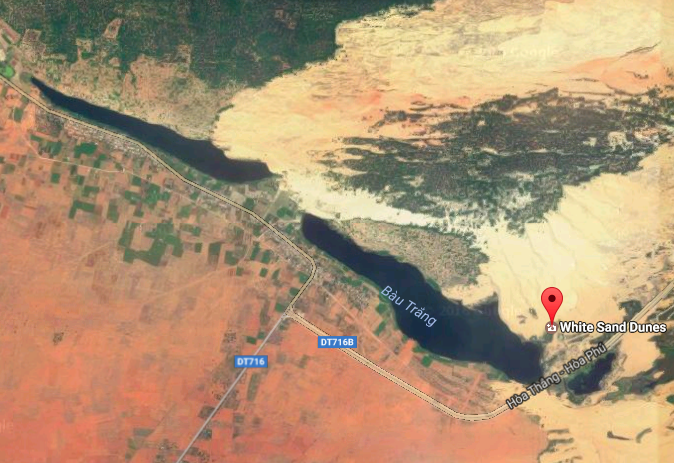
Your first glimpse of the white dunes will probably be from across ones of the big lakes if you’re coming from Mui Ne. This whole area encompassing the lakes and white sand dunes is sometimes referred to as Bau Trang (White Lake). The terminology of the lakes here is very confusing but we think we may have it sussed.
Basically there are three lakes that lie in a linear pattern running along a northwest to southeast line, at the southern edge of the dunes. It’s likely that they once formed a single giant water body that got divided up by the two sand bars we see today.
The long narrow lake to the northwest is referred to as Bau Sen on google maps but it’s also called Bau Ong (Gentleman Lake). It’s about 2km long, reaches 22m in depth and is the middle-sized lake.
In the middle of the three lakes you have the largest lake, referred to as Bau Trang on google maps but it’s also called Bau Ba (Lady Lake). It’s over 2km in length and reaches a maximum depth of 14.5 metres.
Over on the other side of the road you have the smallest of the three lakes, known as Bau Xoai (mango lake), which is only about 600-700 metres in length.

Both Bau Ong and Bau Ba can confusingly be referred to as lotus lake, because they both support colonies of sacred lotus plants (Nelumbo nucifera) in the shallow lake margins. Some tourists try to swim in Bau Ba but caution must be exercised here as local children have drowned here in the past by getting their legs tangled in the underwater stems of the lotus plants.
The lakes are said to be slowly filling in with sand so that in the future, this valuable water source will one day cease to exist and the area will become virtually uninhabitable for humans.
The waters are rich fishing grounds with a variety of freshwater inhabitants including catfish, snakehead and perch and the lake is famous for its giant carp that can exceed 30kg in weight. The indigenous people claim the lakes were once inhabited by crocodiles and that the last one was caught over 25 years ago.
The Cham people that inhabited the area over 1,000 years ago had likely settled on the southern shores of the lakes. In fact, it's likely that the little known history of the area is very rich and complex.
There was once a ruined temple on the south shore of the lake that was built to worship the goddess Tien Y Ana, a goddess also known as Po Nagar. The temple has apparently since been swallowed into oblivion by the shifting sands of the dunes.
Today the southern shore of the lake provides a welcome stand of Australian Pine trees (Casuarina equisetifolia), which provide shade from the sun and are an ideal spot for an afternoon picnic or a nap.
The white sand dunes are strikingly different to the red sand dunes in many ways, not least of which being their colour; they're comprised of much paler, almost white-coloured sand.
When you arrive here and walk along the path towards the dunes, it won’t be long before you encounter this beautiful sacred lotus (Nelumbo nucifera) pond (one of several ponds in the area), where you’re likely to see the magnificent pink blossoms of this plant.

The lotus flower is rich in symbolic meaning, especially for Hindus and Buddhists. It’s a symbol of purity because it emerges from a dirty, muddy pond and yet somehow manages to remain clean and also retain its beauty. It cannot be tainted.
In this pond we observed pink lotus flowers, which are considered to be the supreme lotus (other colours include white, red and blue), associated with the Buddha himself. Not only are lotus flowers spiritually significant; the plant also has many practical uses. The rhizomes and nuts are edible and the flowers are often used to make green tea.
When you first set foot upon these Saharan dunes, you will know that these dunes are in fact the real deal. The red dunes are impressive, yes, but these are on another level. Everything is scaled up. The white dunes are taller, vaster and more majestic. They appear to the eye as an endless expanse of whitish sandy desert with deep troughs, soaring peaks and picturesque curving ridges as sharp as a knife-edge.

We had arrived just in time for the sunset and much like in the red sand dunes, the sun-facing slopes glowed with a surreal golden-orange hue while shadows were cast across the parts of the dunes that couldn’t be reached by the sun’s rays. This landscape was even more photogenic and even more of a photographer’s ultimate playground than the red sand dunes.
We stood high upon a ridge and gazed in awe as the sun slowly descended towards the horizon off to the west. The position of the setting sun means that you're looking out across the glittering lakes as it gradually goes down and the skies take on mesmerizing hues of purple, orange and red, making for some wonderful photo opportunities.


Some practical tips for the white dunes are firstly to beware of the risk of sunburn, especially if you’re exploring them in the midday heat. The white sands are very reflective and can cause severe sunburn in a similar way to the way white snow can.
Also, remember that this is the driest area in Vietnam. It’s literally a desert landscape so bring plenty of water to stay hydrated.
We didn’t have time to explore much of the dunes because we were on foot but if you want to cover more ground, it is possible to rent an ATV near the main entrance. The normal rate is about 400,000 dong for 20 minutes (very expensive).
However, you have to bear in mind that this is a very egotistical, thrill-seeking activity done purely for one’s own pleasure and although that’s not a crime in itself, you do have to also be aware of the disturbance that such a vehicle causes to this sensitive ecosystem. The Vietnamese who hire out the ATVs don’t seem to care either way; nature is money in their eyes it seems.

2. Take an amble along the enchanting 'fairy stream'

The fairy stream or Suoi Tien is essentially a miniature canyon that has been carved out of the sand dunes that lie behind beach by a small, shallow stream.
It can be followed all the way from the sea to its furthest inland reaches, which are about 2km inland. Most tourists follow the stream for about 1.4 km to a point where there’s a small waterfall. You can wade barefoot in the stream for most of the walk, as it’s mostly very shallow.
Bear in mind that the fairy stream is one of the biggest attractions in Mui Ne. A walk along this shallow stream is on the itinerary of virtually every organized tour in Vietnam so don’t be surprised if it’s flooded with suitcase tourists.
Getting there: The fairy stream is found at about the 8km mark if heading east along the main drag of resorts and restaurants in Mui Ne. A small bridge crosses the stream and you can access the stream from underneath this bridge. Signs for ‘fairy stream’ should appear when you get near. We’ve marked the location of it on the map.
The fairy stream begins like any normal stream for the first 300 metres or so, with ordinary vegetation-lined banks. It then suddenly turns into a magnificent miniature canyon, with white limestone cliffs and sand dunes soaring high above you on its left hand side.
You can see just how shallow the stream is here near the beginning of the walk. We recommend that you take off your shoes and do it in bare feet. This way you can feel the cool water and the wet sand between your toes.

It's possible to climb up onto the sand dunes at several places along the walk for some spectacular vantage points:


The contrasting colours of the red dunes and the white limestone cliffs are really magnificent:

A few hundred metres upstream from the bridge entry point, you'll spot the 'Vita Garden Mini-Zoo' with the entrance right by the stream.
This is a relaxing garden that keeps a few animals including porcupines, monkeys, rabbit, snakes, birds and a few others. They also have a restaurant with little thatched huts and fish foot spas where the fish nibble on the dead skin of your feet and give them a pedicure.We didn't visit this place though as we were more interested in exploring the fairy stream.
One thing we absolutely loved here were the limestone rock formations. The limestone cliffs alongside the stream have been eroded by the forces of running water for thousands of years and all that erosion has resulted in some breathtaking sculptures:


There was one very steep slope that was easily accessible from the stream bed. We couldn't resist the challenge of climbing up to the top for the views. It far more challenging to make progress up this slope than we initially expected because of the loose sand. Two steps forward, one step backward...

There's also plenty of wildlife to be found along the fairy stream. There are freshwater crabs, small fish, snakes (we spotted one slender green snake inside a bush), butterflies, wildflowers, strange insects and much more waiting to be discovered.
We were impressed by these beautiful candlebush (Senna alata) flowers. It's actually native to Mexico, which makes it an invasive species here in Vietnam.

Candlebush is an important ornamental but also medicinal plant, used for treating fungal skin infections like ringworm. It's also used in traditional Sinhala medicine in Sri Lanka.
You might also spot the beautiful flowers of the water hyacinth (Eichhornia crassipes), a highly invasive species originally native to the Amazon Basin, that has now become a serious pest in several countries due to its ability to spread rapidly and choke up lakes and ponds. It's now being used as a source of biomass in countries like India where it's a big problem.
.jpg)
Another flower we spotted by the stream was that of the butterfly pea (Clitoria ternatea), also known as Asian pigeonwings. The Latin name comes from the fact that the flower resembles the shape of the female genitals. This plant is native to Indonesia and Malaysia so it's not too far from home.
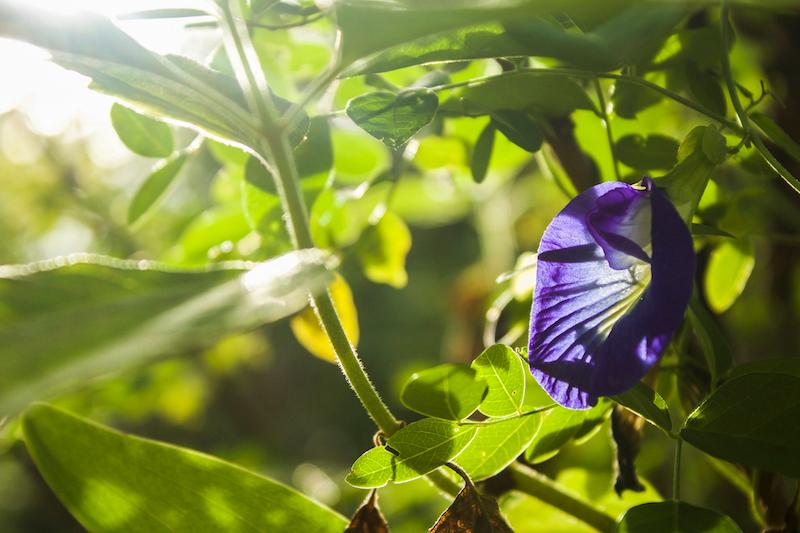
The flower parts are used as a food colouring in some Asian countries (turns rice and drinks blue) and butterfly pea flower tea can also be made by mixing the dried flowers with dried lemongrass. Add lemon juice to this tea and it turns purple!
The sand dunes above the stream also support many bizarre looking insects:
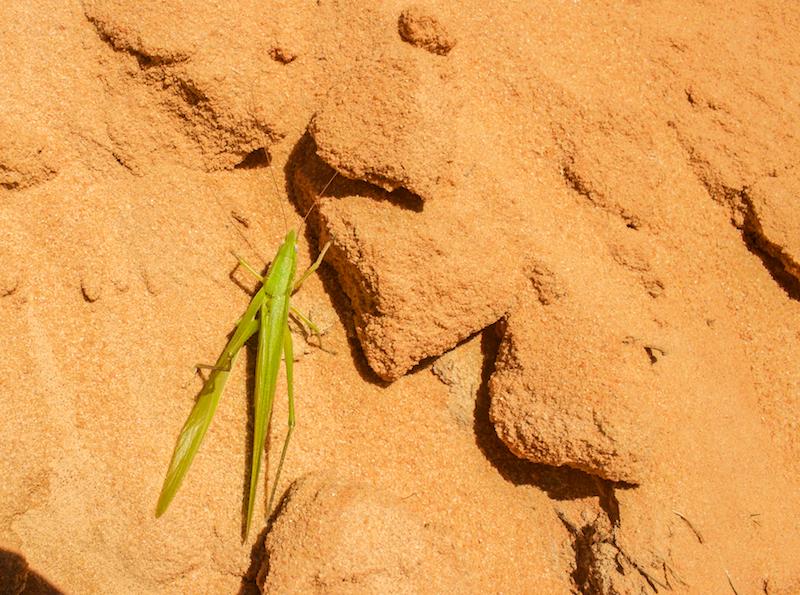
As you continue to walk further inland along the stream, you'll eventually reach a small waterfall, which is not very impressive so don't get your hopes up too much.
A little beyond the waterfall the stream passes under a road and continues for another few hundred metres after that. We didn't follow it all the way to the source because it started to become more difficult to follow, due to thickening vegetation.
We decided to call it quits so we stopped at a small restaurant to slake our thirst by gulping down some coconut water and slake. And then it was on to the next adventure.
3. Visit Mui Ne fishing village
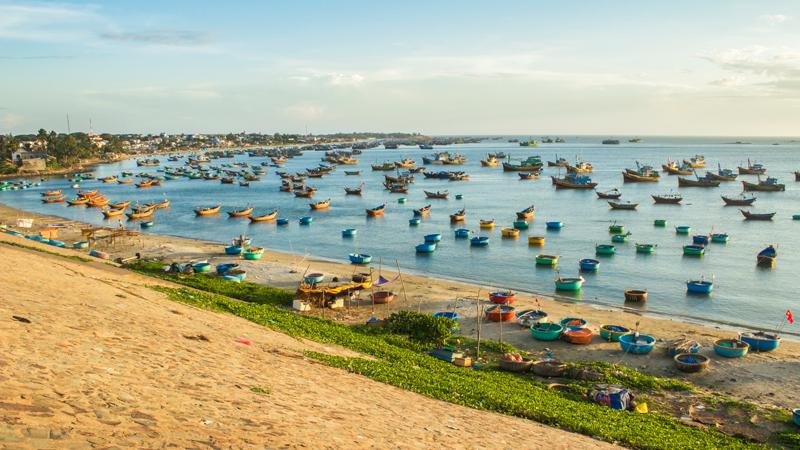
Head east along the coast road from Mui Ne beach and you’ll very soon come to the charming Mui Ne fishing village, which the main tourist drag is named after and which was here long before tourists began coming here to Mui Ne droves.
The harbor here is extremely picturesque with an almost uncountable number of fishing boats and the colourful traditional coracle boats (thung chai). The boats remain moored during the day time, awaiting the fishermen who arrive after sunset and are painted blue, green, red and yellow, making for a scene that is visually spectacular:

One of the best times to visit the harbour is at dawn. At this time, the men return in their coracle boats from a long night out at sea, while women folk await them impatiently by the water’s edge.
Here in Vietnam it’s men’s role to do the fishing while the women’s role is to do the sorting once the catch is landed. The women wear colourful clothing and traditional Vietnamese conical hats made from leaves (Non La). Once the catch is landed they take over from the men and start sorting the various items into baskets and buckets.
The catch normally consists of fish, crabs, scallops, shrimps, prawns and shellfish. Much of the fish will be used to produce the fish sauce (nuoc mam) that Mui Ne is famous for.
During the sorting process, the women often toss aside empty shells after removing the soft parts inside. The discarded shells have accumulated on the beach here over the years, making for an interesting scene.
When we visited we were amazed to find these incredibly colourful scallop shells scattered amongst the shell midden:

While the catch is being sorted, interested buyers begin to show up; restaurant owners, street-sellers and local people. A bustling wholesale market has suddenly sprung into existence right by the edge of the water.
Eventually the activity dies down and the day’s trading comes to an end as the last woman departs from the shore. The beach is once again quiet until the evening time.

Sunset is another magical time to come here. The sun sets directly over the ocean, casting its stunning golden light upon the water and the fishing boats.
After sunset fishermen load their boats up with nets and other fishing gear and paddle out to sea for another long night of fishing. If you’ve ever seen it, the way they manoeuvre the boats is interesting.
There’s a single wooden oar mounted to the edge of one side of the boat and they move the paddle in a figure-of-8 type of motion. They often have to fight the large incoming waves in these tiny boats until they’re finally beyond the surf zone where the waves are breaking.
If you think about it, these men are heroes, spending long nights out at sea working hard to feed the entire village. What they do is truly commendable.

4. Try the watersports
.jpg)
There’s a healthy array of watersports on offer here along the main stretch of Rang beach. Take your pick between windsurfing, surfing, stand-up paddle surfing, kitesurfing, jet-skiing, sailing and kayaking, but Mui Ne is best known for kitesurfing and windsurfing.
Mui Ne competes with Boracay in the Phillipines as the kitesurfing capital of Southeast Asia. It’s considered by many to have the best conditions in Asia for wind-based watersports, due to the low rainfall, warm water and the strong, consistent cross-onshore winds it receives during the high season.
Mui Ne has an average of 227 days per year with wind speeds over 12 knots. The waters in the kiting areas are also safe for watersports because they’re relatively free of dangerous rocks.
As for optimal conditions, the winds blow hard from late October to late April with December and January considered to be the peak months. Winds are weaker and less consistent during the monsoon season (May – September).
There are currently over a dozen kitesurfing operators in Mui, run by both foreign and Vietnamese instructors with new ones popping up all the time. You’ll find most of them near the west end of the main beach. One of the more reputable operators is C2sky, being the one and only IKO (International kitesurfing organization) certified school in Mui Ne.
Some of the operators also offer lessons in surfing and other watersports. The rates for kitesurfing lessons are about $50 per/hr with a package of 5 lessons usually available for about $250. Vietnamese operators may be cheaper than the foreign ones so bear that in mind if you’re considering taking lessons.
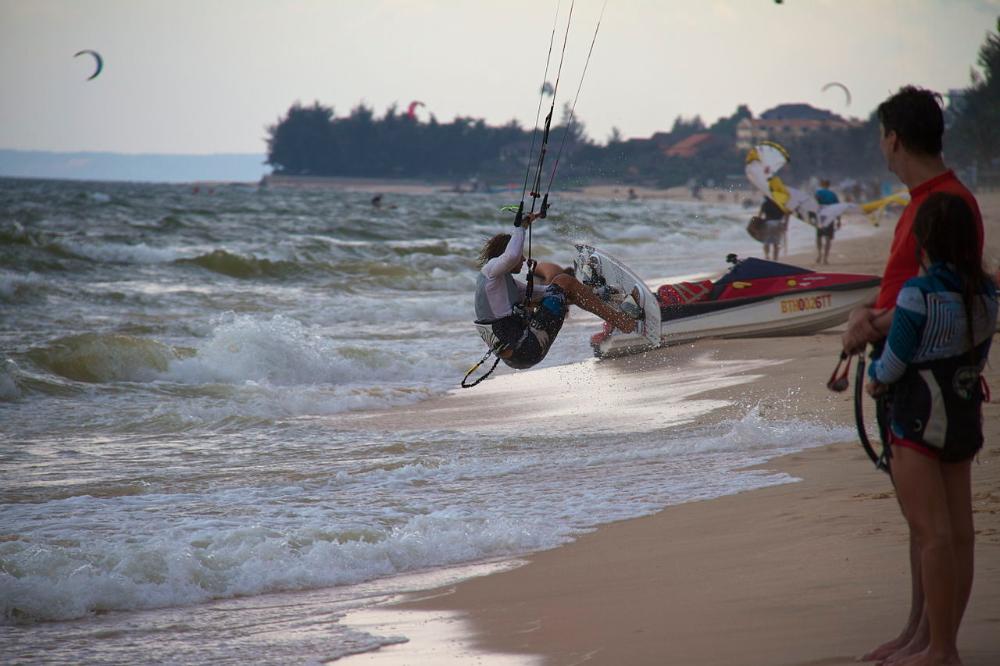
Many of the operators actually offer a free kitesurfing lesson, hoping that you’ll get hooked on the sport and sign up for a series of lessons. We went for a stroll along the beach and were soon offered a free 1-hour lesson by one of the Vietnamese operators.
The instructor taught us the basics, like how to control the kite and keep it airborne by tilting the handlebar from side-to-side. We then went swimming in the sea with the kite while holding onto the instructor and by doing so we were able to get a feel for controlling the kite while in the water. It was excellent fun and we did want to take more lessons afterwards, but there was no way we were paying those kinds of rates for lessons.
Kitesurfing can get a little dangerous during the peak season, where it’s not uncommon for over 300 kitesurfers to be sharing the same stretch of water at the same time (quite a spectacle to behold).
Collisions between kitesurfers or between kitesurfers and swimmers do occasionally happen and medical facilities at the beach are limited in terms of equipment and skill, so weigh up the risk if you want to go out when the seas are crowded with other kitesurfers.
5. Visit the Po Shanu Cham ruins
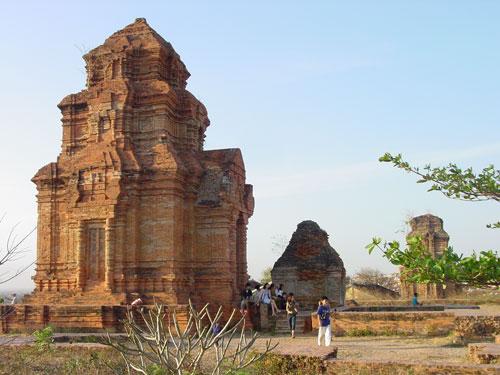
The Po Shanu Cham Ruins consists of a group of three ruined Cham towers that are perched on a hilltop overlooking Phan Thiet.
Getting there: Head west towards Phan Thiet on Nguyen Thong road. You have to make a left turn off the main road about 4.5 km from the extreme west end of Rang beach. This left turn brings you to the hilltop where the ruins are found.
The cham towers are part of a larger complex known as the prince’s castle, which encompasses a group of hills, the beach, the towers, a modern pagoda, a famous Poet’s tomb (Nguyen Thong) and the ruins of a large French estate, where the term ‘Prince’s castle’ derives from.
It was in fact in 1911 when a French prince and Duke De Montpensier came to Phan Thiet to seek out good hunting grounds and the prince grew so fond of this spot that he bought the entire hill from the French authority in Binh Thuan and built a splendid villa here, just 100 metres south of the Cham towers.
.jpeg)
The three towers are found on Ong Hoang (Mr.Heaven) hill and were originally accompanied by a temple, which has supposedly been buried beneath the ground for over 300 years. The towers were restored from 1990-2000 to how they appear today.
The towers were originally erected by the Cham people in the late 8th century, to worship the Hindu God Shiva. Inside the main tower there’s an altar on which you’ll find a couple of lingga-yoni (symbolizes the hindu God Shiva and also the indivisible two-in-oneness of male and female).
Today, local fishermen often come to the towers to pray for good weather conditions before heading out to sea. They sometimes refer to two of the towers as the king and queen or God and Goddess of the sea. The towers also serve as an important navigational landmark for ships and vessels out at sea.
The hilltop was also used as a strategic military base during the recent Vietnam war so it’s a good idea not to poke around the nearby fort too much, just in case there’s any unexploded ordinance in the area. The towers are perfectly safe to explore though.
What about the beaches?
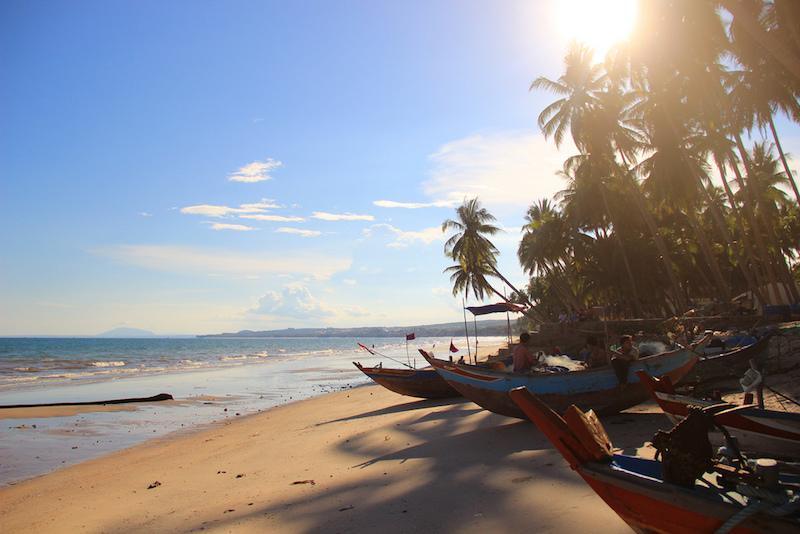
The 10km long Rang beach is definitely one of the better beaches in Vietnam in terms of overall facilities but it does have some downsides. Coastal erosion has been a problem here over the years and in many areas the water now comes right in at high tide, covering the sand completely. Some resorts have even lost their beaches completely.
Another issue is that many resorts and other properties are located on the beachfront, which means that it can often be difficult to gain access to the beach along the main drag. Many of the resorts also consider the stretch of beach behind their property to be their own (regardless of whether they legally own it) and security may come out and shoo you away if you try to plonk yourself down on their plot.
The alternative of using the public stretches of beach can also be problematic as some of these areas can be strewn with rubbish or used as a toilet by locals.
As regards swimming, Rang beach may not be the best place to do so. You may have to contend with jetskis, kitesurfers and other hazards but even if that's not an issue, the water quality is said to be fairly marginal, with somewhat high pollution levels, especially after heavy rains and near outflows from local rivers.
Mui Ne also has two other much quieter and more pristine beaches, which some people will surely prefer to Rang beach.
Ganh beach or Hon Rombeach as it's also called, runs along the eastern edge of the Mui Ne peninsula, passing right alongside the red sand dunes and ending at Hon Rom village. It's a great beach for an evening or morning stroll but not ideal for swimming because the dangerous rip tides and also because of its use as a harbour for the Mui Ne fishing boats for half of the year.
Further north along the coast, around the next headland, a long uninterrupted stretch of beach runs alongside the road that leads to the white sand dunes. This is Suoi Noc beach and it's a beautiful and desolate stretch of sand that's over 10km long, perhaps even longer than Rang beach. The loneliness is usually only disturbed by shepherd boys herding their goats and cows along the beach.
Near Binh Thien, the village at the far north end of Suoi Noc beach, there's also small island called turtle island that can be accessed at low tide.
Watch Video:
Recommended Guidebook: Lonely Planet Vietnam
Have you ever been to Mui Ne? If so, what did you love most about it? Leave us a comment below.
JOIN OUR LIST
SUPPORT US
FOLLOW US
ABOUT US
Our names are Eoghan and Jili and we hail from Ireland and India respectively.
We are two ardent shoestring budget adventure travellers and have been travelling throughout Asia continuously for the past few years.
Having accrued such a wealth of stories and knowledge from our extraordinary and transformative journey, our mission is now to share everything we've experienced and all of the lessons we've learned with our readers.
Do make sure to subscribe above in order to receive our free e-mail updates and exclusive travel tips & hints. If you would like to learn more about our story, philosophy and mission, please visit our about page.
Never stop travelling!
FOLLOW US ON FACEBOOK
FOLLOW US ON PINTEREST
-lw-scaled.png.png)


